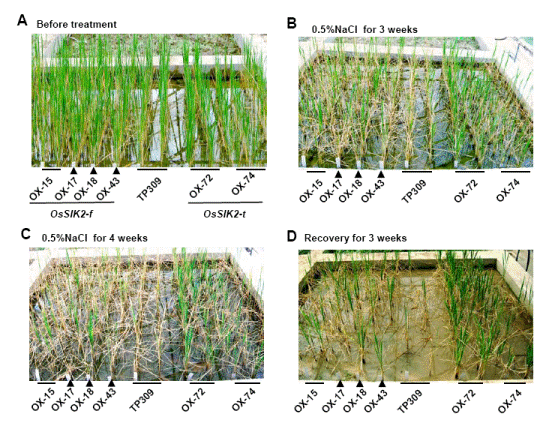Rice and other crops are often exposed to various abiotic stresses and yield is drastically affected. Receptor-like kinases (RLKs) play important roles in plant development and defense responses; however, their functions in abiotic stresss responses remain unclear.
Here, the scientists from Prof Zhang Jin-Song’s lab and Prof Chen Shou-Yi’s lab demonstrate that OsSIK2, an S-domain receptor-like kinase from rice, improves abiotic stress tolerance and delays leaf senescence. OsSIK2 protein is localized on plasma membrane and has kinase activity. The gene can be induced by salt, drought, cold, dark and ABA treatment. Transgenic plants overexpressing OsSIK2 showed better performance under salt and drought stress compared to controls. It is interesting to note that a truncated version of OsSIK2 without most of extracellular region confers much higher salt tolerance than the full-length OsSIK2 in transgenic rice in a controlled salt-stressed soil system (Figure 1). While both protein versions may enhance stress tolerance through activation of anti-oxidative ability, the full-length and the truncated proteins also regulated different sets of downstream genes. The full-length OsSIK2 can activate PR-related genes whereas the truncated OsSIK2 specifically promoted DREB-like genes. Moreover, seedlings of OsSIK2-overexpressing transgenic plants exhibit early leaf development and delayed dark-induced senescence phenotype. All the above downstream genes were also induced by salt, drought and dark treatment. The OsSIK2 gene and its truncated version may be used for genetic improvement of rice and other crops for stress tolerance.
This work has been published online on Oct 18, 2013, in ‘Plant Physiology’ doi:10.1104/pp.113.224881. Dr. Chen Li-Juan and Dr. Wuriyanghan Hada contributed equally to this work. The work is supported by 973 project, National Natural Science Foundation of China etc.

Figure1, Performance of OsSIK2-overexpressing transgenic plants under field condition. OsSIK2-f indicates lines harboring the full-length OsSIK2 whereas the OsSIK2-t indicates lines containing the truncated gene without the region coding for extracellular domain of OsSIK2.
(A) Plant growth before salt treatment.
(B) Performance of various lines after salt stress for three weeks.
(C) Performance of various lines after salt stress for four weeks..
(D) Plant growth after recovery from salt stress.



